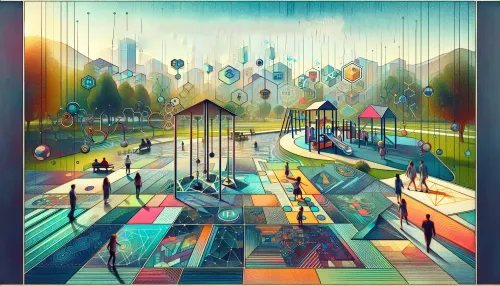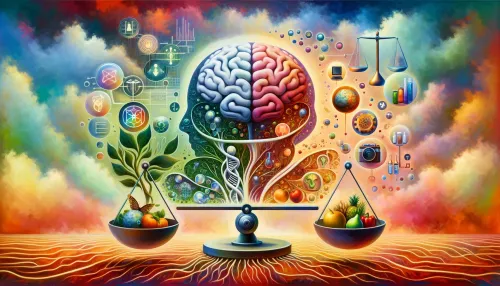Harnessing the Power of Micro-Moments: Autism's Role in Neurodiverse Innovation

Autism, a complex neurological condition, often brings forth unique perspectives and cognitive approaches that can profoundly impact various industries, particularly in the realm of technology and innovation. This article explores the concept of micro-moments in autistic thinking, delving into its potential for fostering innovation and driving advancements in both workplace dynamics and product development. From amplifying creativity to advocating for inclusive design thinking and policy implications, the influence of neurodiversity in innovation is profound and multifaceted.
Exploring the Concept of Micro-Moments in Autistic Thinking
Autistic individuals often experience micro-moments, characterized by intense focus and deep immersion in specific interests or tasks. These micro-moments represent a form of cognitive intensity that enables individuals to process information with exceptional detail and precision. The neurodiverse nature of these cognitive patterns gives rise to unique ways of problem-solving and approaching challenges, offering fresh perspectives that can revolutionize conventional practices in various industries.
How Neurodiverse Perspectives Amplify Creativity and Problem-Solving in Tech Industries
In the tech industry, neurodiverse perspectives bring a wealth of creativity and unconventional problem-solving strategies. Autistic individuals exhibit an innate ability to identify patterns, detect anomalies, and think outside the box, qualities that are highly sought after in fields such as software development, data analysis, and cybersecurity. These distinctive cognitive traits not only contribute to innovation but also enhance the overall adaptability and resilience of tech-driven solutions.
Related Article: Unveiling the Kaleidoscope of Innovations: Navigating the Challenges of Autism with Creative Problem-Solving
Real-World Examples of Autistic Individuals Driving Breakthroughs Through Unique Insights
Numerous success stories underscore the critical role of autistic individuals in driving breakthrough innovations. For instance, in software development, autistic professionals have been pivotal in optimizing algorithms for efficiency and accuracy. Additionally, their contributions to user experience design have led to more intuitive interfaces that cater to a diverse range of users. These real-world examples exemplify how embracing neurodiversity can lead to groundbreaking advancements within the tech sector.
Strategies for Businesses to Tap into the Autistic Talent Pool for Competitive Advantage
To fully leverage the potential of autistic talent, businesses must implement tailored strategies that accommodate diverse cognitive styles. Creating inclusive recruitment processes, providing mentorship programs, and fostering a supportive work environment are essential steps toward tapping into the autistic talent pool. By recognizing the value of neurodiversity and actively seeking out autistic individuals for employment opportunities, businesses can gain a competitive edge through enhanced creativity and innovation.
Related Article: Pioneering Innovations Through the Autistic Lens: A Global Showcase of Talent and Creativity
The Role of Inclusive Design Thinking in Leveraging Neurodiversity for Product Development
Inclusive design thinking involves considering the needs and preferences of all users, including those with diverse cognitive abilities. By integrating neurodiverse perspectives into product development processes, companies can create solutions that are more intuitive, accessible, and user-friendly for a broader audience. Harnessing the strengths of autistic individuals in design thinking not only fosters innovation but also promotes social responsibility by ensuring equitable access to technological advancements.
Unlocking New Avenues of Communication: Autism and the Evolution of Empathetic Technology
The unique communication styles associated with autism have spurred the development of empathetic technology aimed at facilitating meaningful interactions and social connections. Innovations such as emotion-recognition algorithms, personalized communication devices, and virtual reality platforms have emerged from the intersection of autism and technology. These advancements not only cater to the specific needs of autistic individuals but also contribute to the evolution of communication technologies that benefit society at large.
Related Article: Revolutionizing Autism Support Through Telepresence Robots
Bridging the Gap Between Neurodiverse Insights and Mainstream Market Needs
An essential aspect of incorporating neurodiverse insights into innovation involves bridging the gap between specialized solutions and mainstream market needs. Through targeted market research and user feedback mechanisms, companies can ensure that products developed with neurodiversity in mind align with broader consumer demands. This approach not only broadens the impact of neurodiverse innovation but also fosters greater acceptance and integration of diverse perspectives within mainstream markets.
Reinventing the Workspace: Creating Environments Where Autistic Talent Can Thrive
Establishing inclusive work environments entails reimagining traditional workspace dynamics to accommodate diverse cognitive styles effectively. Factors such as sensory considerations, flexible work arrangements, and clear communication protocols play a pivotal role in creating conducive settings where autistic talent can thrive. By embracing neurodiversity in workspace design, companies can cultivate a culture of inclusivity that nurtures creativity and empowers all employees to contribute meaningfully to organizational goals.
Collaboration or Solo Genius? Analyzing the Work Patterns of Neurodiverse Innovators
The work patterns of neurodiverse innovators often vary significantly from conventional paradigms. While some individuals excel in collaborative settings that leverage collective insights, others thrive when given autonomy to pursue independent projects. Recognizing and accommodating these diverse work patterns is crucial for maximizing the contributions of neurodiverse talent. By offering flexible work arrangements tailored to individual preferences, organizations can harness the full potential of neurodiversity within their innovation ecosystems.
Policy Implications: Advocating for Neurodiversity-Driven Innovation at the Governmental Level
Advocacy for neurodiversity-driven innovation extends beyond corporate initiatives, encompassing policy advocacy at governmental levels. By promoting legislation that supports inclusive employment practices, invests in research on neurodiverse cognition, and fosters collaboration between academic institutions and industry stakeholders, policymakers can facilitate an environment conducive to harnessing neurodiversity for innovation. These policy interventions not only promote diversity and inclusion but also spur economic growth through enhanced innovation across various sectors.
In conclusion, autism's role in fostering neurodiverse innovation is a compelling testament to the transformative power of diverse cognitive perspectives. By embracing micro-moments in autistic thinking, leveraging inclusive design thinking, and advocating for policy changes that support neurodiversity-driven innovation, businesses and society at large stand to benefit from unprecedented creativity, resilience, and societal impact.
Frequently Asked Questions
Micro-moments in autistic thinking refer to periods of intense focus and deep immersion in specific interests or tasks. These moments allow autistic individuals to process information with exceptional detail and precision, leading to unique problem-solving approaches that can significantly impact various industries.
Businesses can leverage autistic talent by implementing tailored strategies such as inclusive recruitment processes, mentorship programs, and supportive work environments. Recognizing the value of neurodiversity allows companies to tap into unique cognitive styles, enhancing creativity and driving innovation across their operations.
Policy plays a crucial role in promoting neurodiversity-driven innovation by advocating for inclusive employment practices and investing in research on neurodiverse cognition. By fostering collaboration between academic institutions and industry stakeholders, policymakers can create an environment that supports diverse perspectives and enhances economic growth through innovation.
Check Out These Related Articles

The Adoption of AI Speech Therapists in Homes of Autistic Children

The Revolution of Smart Playgrounds for Autistic Children

Visionary Insights: Anticipating the Next Wave of Autism Support Innovations
